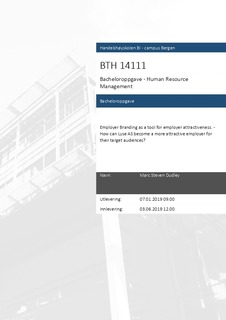Employer Branding as a tool for employer attractiveness. -How can Lyse AS become a more attractive employer for their target audiences?
Bachelor thesis
Permanent lenke
http://hdl.handle.net/11250/2620343Utgivelsesdato
2019Metadata
Vis full innførselSamlinger
- Bachelor [817]
Sammendrag
Purpose of this paper
Lyse AS is a corporate group operating in the Energy and technology industries
and like their competitors they are in search of the best-skilled workers. After the
oil crisis in 2014, which saw the unemployment rate increase from 2,1% to 4,5%,
the labour market is now recovering. Competition for talent is fierce as both oil
and IKT companies in the region are also searching for the best-skilled workers.
Turnover at Lyse has increased by 40% between 2015 and 2017, and the
challenge for Lyse is, therefore, not only to be an attractive employer for the bestskilled
workers in engineering, business and IKT, but also to retain the most
talented employees after they join the company. The purpose of this paper is to
answer the following question: How can Lyse become a more attractive employer
for their target audiences? Also, the aim is to find out if there are any
demographic differences between gender, age, education field and student or nonstudent
status. Finally, it will be essential to find out the effect digital platforms
have on employer attractiveness, as this is the modern way of communicating
with the target audiences. Answering these questions will help Lyse implement an
employer branding strategy and help them be competitive in the labour market.
Methods used to answer the questions
Previous research on employer attractiveness, including the most valued attributes
when choosing an employer, was used to construct a quantitative questionnaire.
17 items in the employer attractiveness scale were used to identify which
attributes are valued the most and 236 subjects in Lyses target groups participated.
Questions about the effect a company’s webpage, social media and job application
system can have on employer attractiveness was also answered by participants.
Secondary data was also used to help identify what current applicants feel about
the organisation.
Results
The research identified 16 of 17 items being essential when choosing an employer
and especially development and social value are important for all subjects in the
sample group. The perceived importance levels of the different attributes varied
between male and female participants, as females generally scored higher on all
attractiveness attributes. The perceived importance levels of the components of
employer attractiveness partially varied according to the education field and age, but not between students and non-students. Results also show that social media
has an essential role in communicating with the target audiences, and poor userfriendliness,
visual representation and content on a company’s website and job
application system has a demoralising effect on job applicants.
Conclusion
To become a more attractive employer, Lyse must develop an employee value
proposition (EVP) by combining the results from this research with the attributes
that current employees find most attractive. This means further analysis internally
is the next step, to be able to identify any similarities between the external target
groups and the current employees. It will also be important to identify critical
areas among the attributes that need improving internally. Linking the EVP to the
identity, corporate brand and vision of Lyse will be important to help current
employees identify themselves with the employer brand. Finally, by using social
media and the company’s webpage to communicate with their target audiences,
Lyse has the tools in place to succeed in becoming a more attractive employer.
However, as employer branding is an on-going process and not a short-term
project, it requires investing the necessary resources. Only then can Lyse achieve
their goal of becoming a more attractive employer for their target audiences.
Beskrivelse
Bacheloroppgave i Human Resource Management fra Handelshøyskolen BI, 2019
